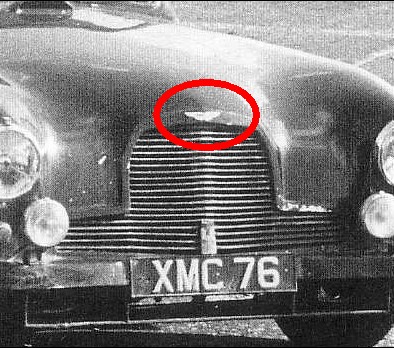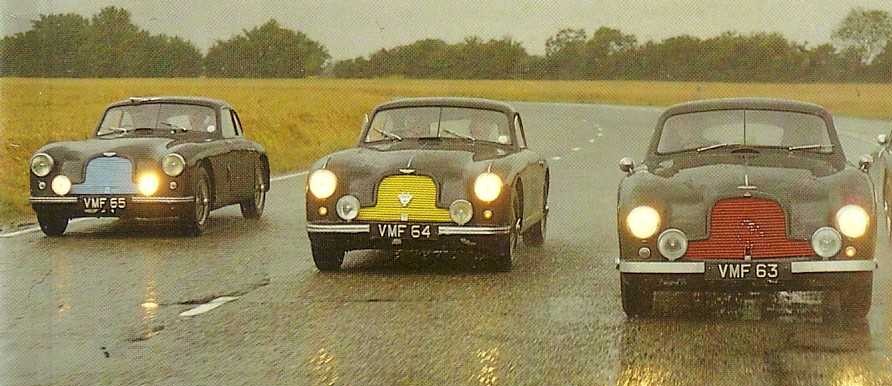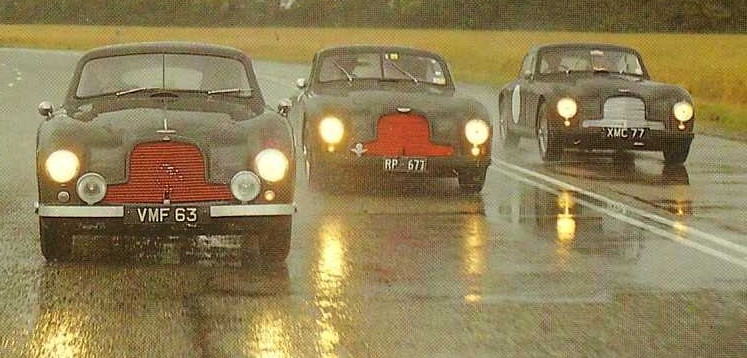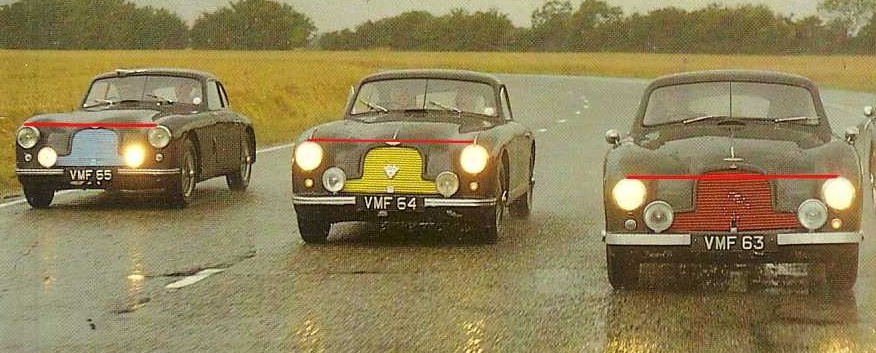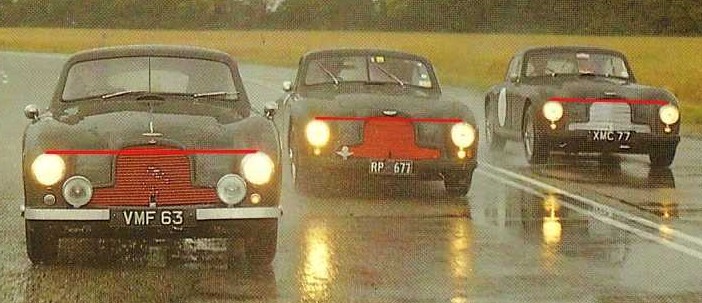THE WASHBOARD REGISTER
ASTON MARTIN DB2
LML/50/7, 8 & 9 body mods
PLEASE DO NOT HESITATE
TO SEND
CONTRIBUTIONS !
LML/50/7, LML/50/8 and
LML/50/9 were built for racing.
Nevertheless, they only differed from stock Vantage specs by outsize
fuel tanks, racing clutch and brake linings. They were fully trimmed!
Their bodies (without body number by the way) have seen some changes
along the seasons...
FIRST
TYPE OF BODY
Of course they had 3
pieces grille and washboards but not yet the production bonnet scoop.
As they needed much air for cooling their engines when racing, they
received some "holes".
THIS TYPE OF BODY IS UNIQUE TO
THOSE THREE WORKS CARS.
I put RED
ARROWS to show you apertures...
You can see TWO ROUND HOLES on the top of the bonnet (one at the centre
and one near the windscreen just in front of the driver) and TWO
RECTANGULAR HOLES at each side of the front grille.
There are also some things to say about gas tanks.
The YELLOW
ARROWS show the two
stock production flaps for filling.
The BLUE
ARRROWS show flaps located on the roof for filling fuel tanks
that were inside
with the drivers! These were of 40 gallons (182 litres) capacity and of
welded
aluminium, especially made by Delaney-Galley of Cricklewood from Claude
Hill's drawings. The driver operated the flush-fitted filler
caps by pulling a ring fixed to wires.
Thus only 5 pit stops had to be done at Le Mans.
The GREEN
ARROWS show a little round window as the one sometimes used to
show the tax disc in UK. Friend Dom recently found out: this is a
device that enabled to put a colour disc to know which car came for a
pit stop! Later (from third body type on) the grille is also painted. A
photo of this device (which came from aviation industry) is to be found
anon.
This things appears on several racing DB2s by the way.
LML/50/8 at Le Mans in 1950
(Original photo source: BRITLM)
Production flaps as seen on
LML/50/7.
(Original photo source: AM Magazine vol 21 no 88)
LML/50/8
(Original photo source: FRO)
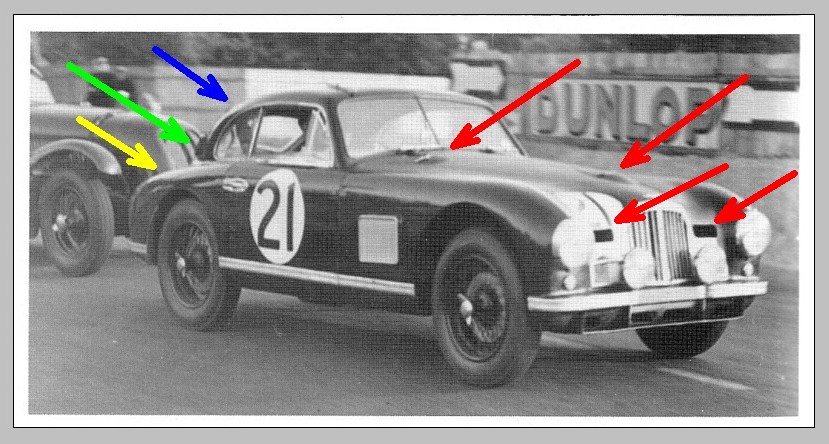 LML/50/7 at Le Mans in 1950.
LML/50/7 at Le Mans in 1950.
HERE YOU CAN CLEARLY SEE THE RECTANGULAR "HOLES" AROUND THE GRILLES
AND ALSO LARGE PIPES COMING DOWN THE ROOF TO THE INSIDE TANK (under
blue arrow).
(Original photo source: BRITLM)
Just for comparison, here is
LML/49/3 (hence DB MkII with the previous body style). It has a 48
gallons tank that is clearly visible behind the seats.
 Blue arrow points filler cap that was not flush fitted
on the DB MkII, contrary to those to be found on the works DB2s.
Blue arrow points filler cap that was not flush fitted
on the DB MkII, contrary to those to be found on the works DB2s.
The tank is even bigger on the DB MkII! (48 gallons vs. 40 gallons, 218
liters
vs. 182 liters)
 (Source : RAC1)
(Source : RAC1)

Looks like right roof flap had to
be taped to stay close...
Here is a close-up of the "round
thing" shown by the green arrows.
Thanks Dom for that. Please
note blue colour (hence it's VMF 65).
SECOND TYPE OF BODY
STANDARD PRODUCTION WASHBOARD
BODY.
Much sleeker body! Standard body WITH bonnet airscoop.
Changes were done for Silverstone in September 1950.
LML/50/9 at the
1952 Daily Express (Moss &
Macklin)
LML/50/8 at
Silverstone 1950
(Source AM Magazine vol 20 no 82)
You can notice that, as was done with earlier DB MkIIs,
that some
vertical slats of the grille (one out of two) were removed to help air
induction.
Several months later, the new grille was released (beginning with
chassis number LML/50/50).
Here is a nice line up mixing both styles at Silverstone
AMOC
meeting (1951)...
From left to right: LML/50/34,
LML/50/64, LML/50/57, LML/50/59
and LML/50/9
(Source: AM Magazine v20
n82)
THIRD TYPE OF BODY
STANDARD PRODUCTION BODY
(LATER TYPE : WITHOUT WASHBOARD).
Rear enclosed numberplate was kept (for a while) but front grille was
updated in
order to look like production models that had changed.
See my page about rear plates
and my page about why the grille was
changed.
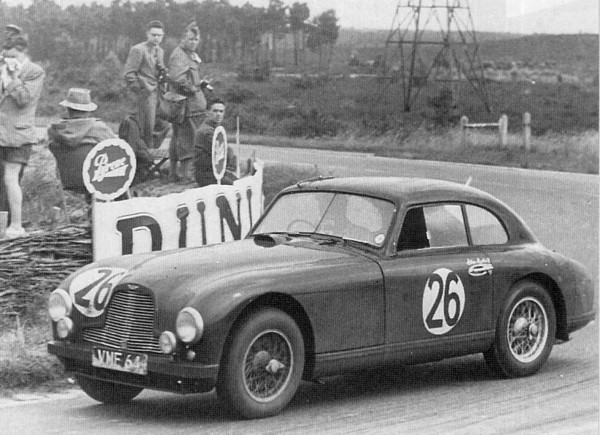 LML/50/8 at Le Mans in 1951
LML/50/8 at Le Mans in 1951
(Source: POST)
Well, actually, there is a difference
with the production DB2: the badge.
On the works cars it is located ON
the lip around the grille, as on the DB3.
On the production cars (even privateers' racing cars), it is ABOVE.
FOURTH
TYPE OF BODY : HIGHER HEADLAMPS
Although I have read many articles, books and so on about Aston
Martin, I have never seen a sentence about this fourth look.
In fact I discovered this recently and made a page in April 2008. Have a look here.
I won't repeat every thing but this fourth type of body only affects
headlamps height: they are higher as on the DB2/4 to come.
Several topics have been made around the world and nobody has the
answer for that.
It has been said that it could have been a problem with rules but it
can't be that as both the heights were to be found racing in the same
races...
Here is an interesting photo: you have four DB2s on this one and
you can see the 2nd, the 3rd and the 4th body styles side by side!
(Source RAC2)
The race is the 1951 Tourist Trophy. First is Lance Macklin in the DB3
prototype.
Have a look at the four DB2s :
No 24 (driven by Peter Clark) is LML/50/57: 3rd body style
(with badge above).
No 23 (the '3' is quite hard to read I confess), reg VMF 65, is
LML/50/9 driven by Eric Thompson. VMF 65 still appears with the 3
pieces front, i.e.2nd body style
(to be changed later).
No 21 is XMC 77, chassis LML/50/55, one of the two works
'lightweights', driven by Abecassis.
Just behind, you might see its sister XMC 76 (LML/50/50). Taylor is at
the wheel.
Both XMCs have the 4th body style.
Several DB2s received this front end. Some period (hence making
them true fourth style) and some, I think, later maybe from a DB2/4.
BUT THERE IS MORE
TO COME !
Look at this nice photo of LML/50/8
below (source eBay)
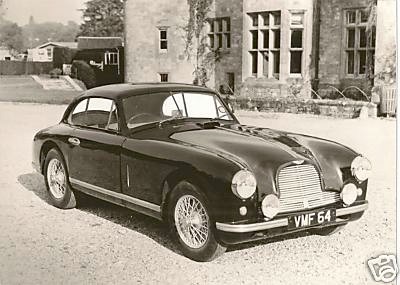
This is VMF 64 with the fourth body
style!
What's much more surprising is
looking at the three VMFs and two XMCs as they appear now...
They were reunited in 1987:
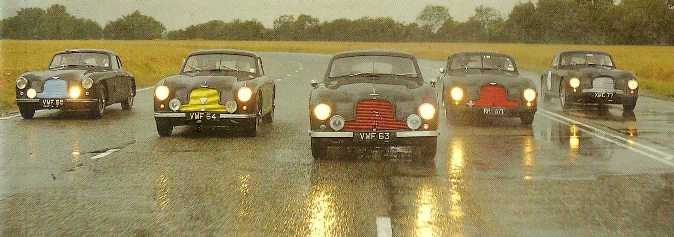
and at Silverstone in 2001:
(Thanks José for this
photo)
Let's seen them all bigger and side
by side and PLEASE LOOK AT THE
HEADLAMPS!
So what?
VMF 64 and VMF 65 have been upgraded to fourth body style...
and XMC 76 and XMC 77 have been downgrade to third body style! (like
VMF 63 I put there for comparison)
Concerning VMF 64 & VMF 65 and XMC 76 & XMC 77, this
could simply be a bonnet
swap...
Now
we'd like to find when
this was made!
Mille Miglia 1953
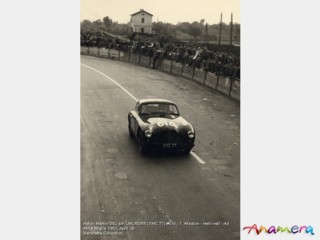
Source Anamera. Nothing can be seen for sure. So I made a zoom and
reworked the photo:
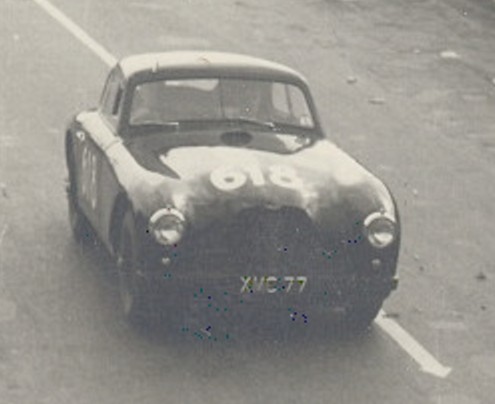
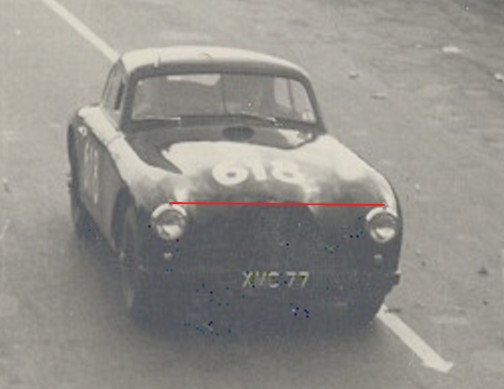
So in 1953 XMC 77 still had "high headlamps"
Here is a photo of XMC 77 at the 1954 Alpes rally. XMC 77 has the
low
headlamps!
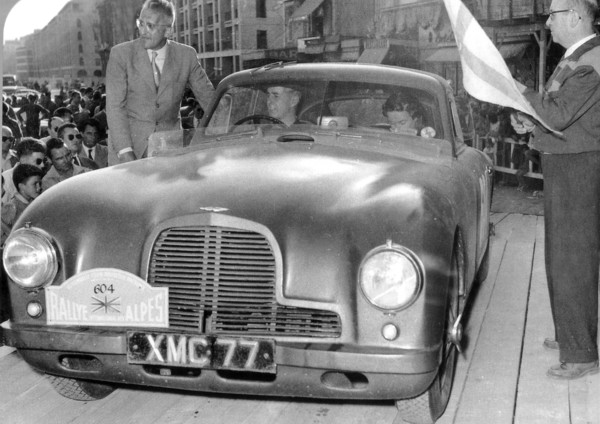
(Source: AMEC)
Aston Martin Scrapbook
http://astonuts.free.fr







